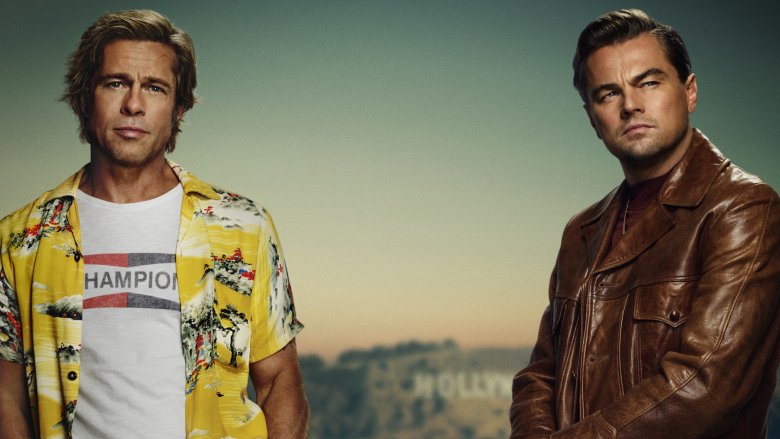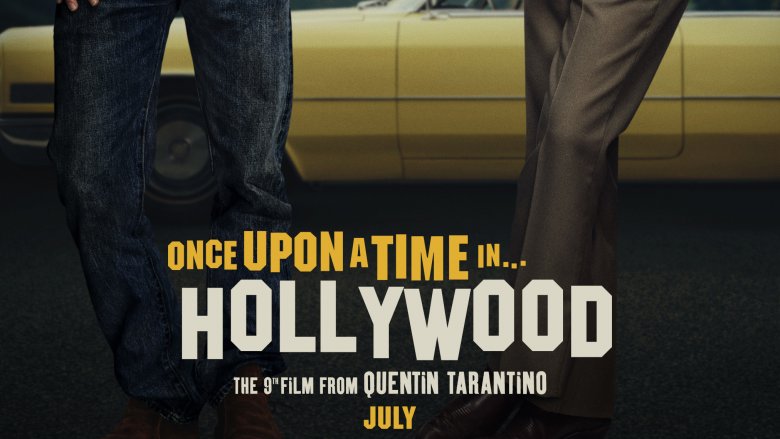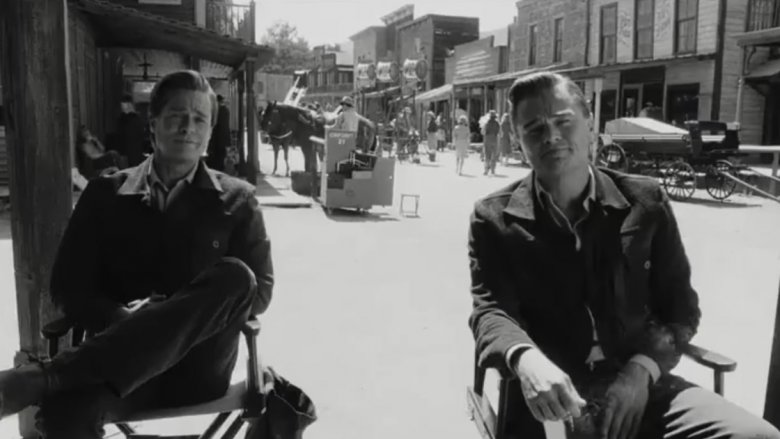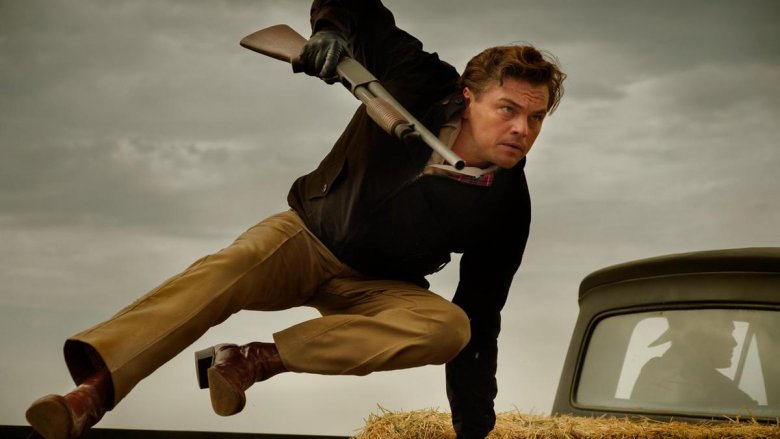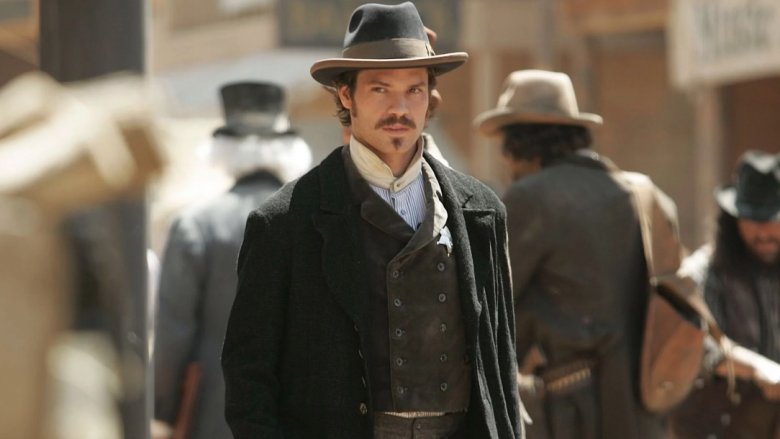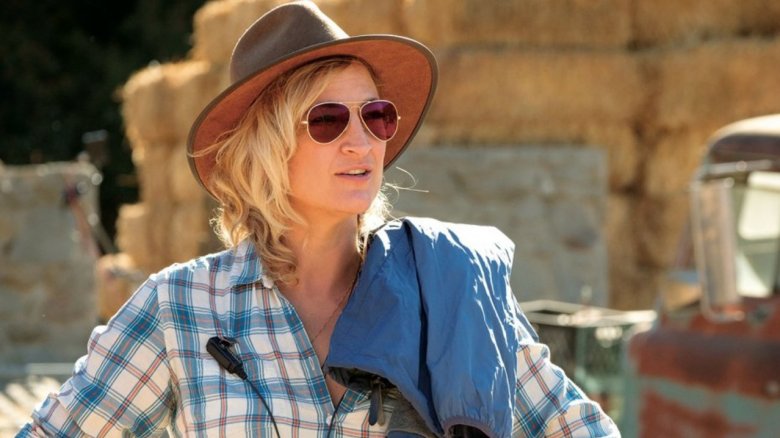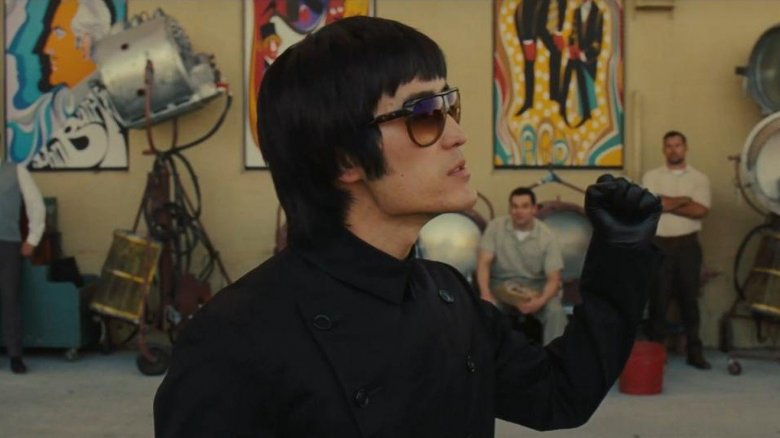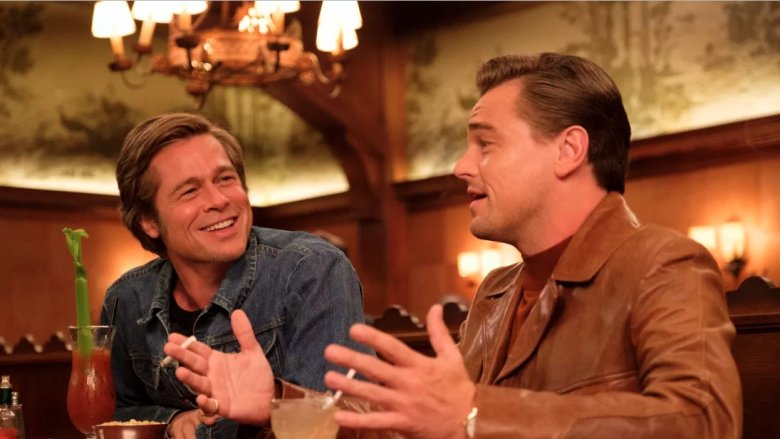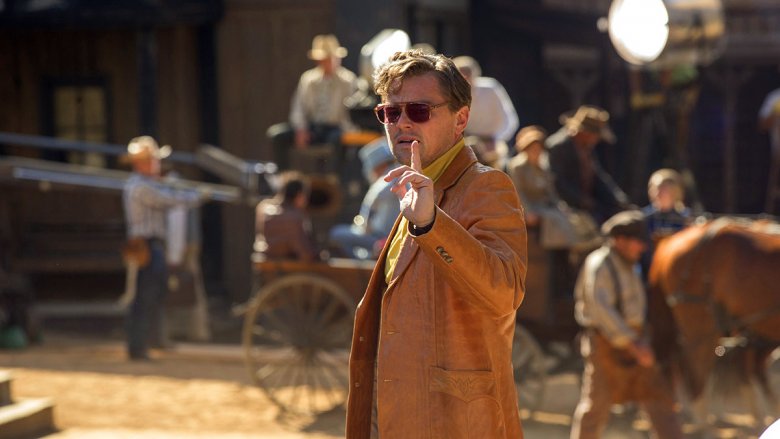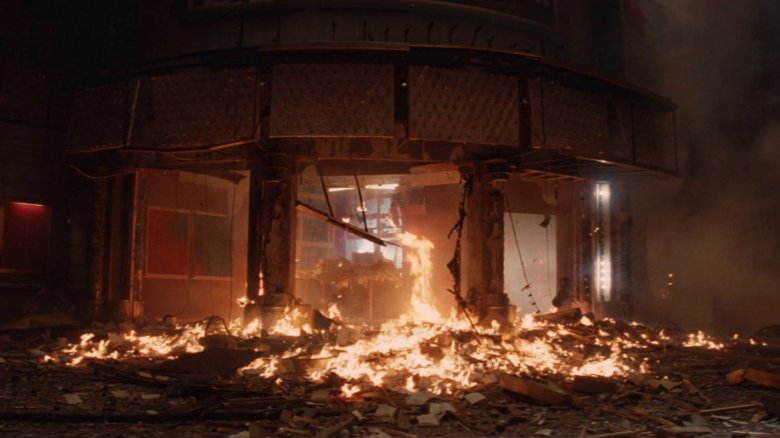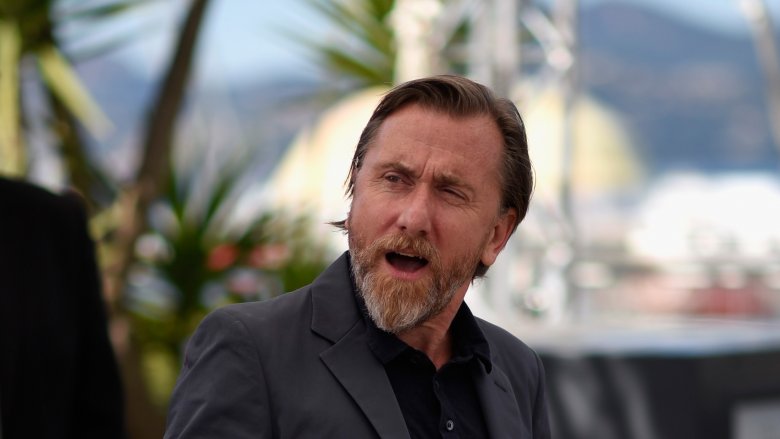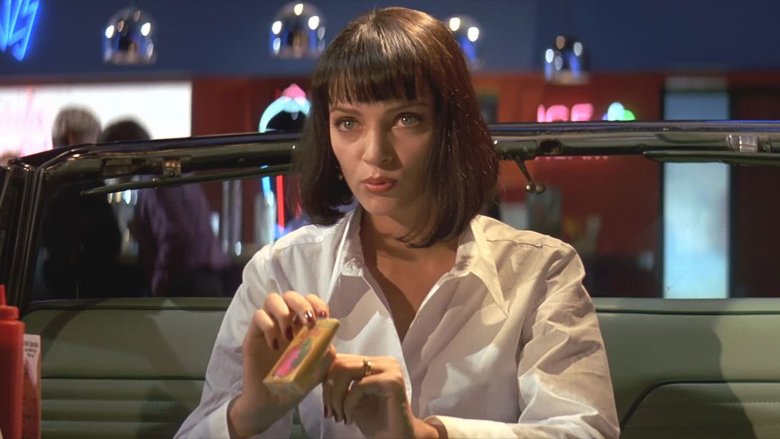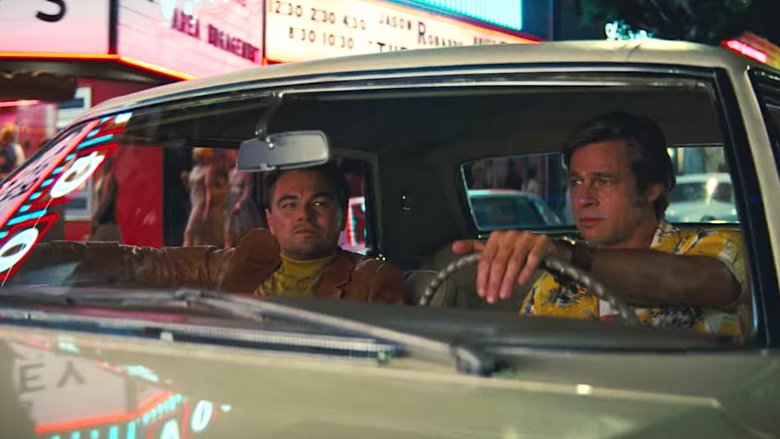Small Details In Once Upon A Time In Hollywood You Missed
While Quentin Tarantino's films are often known for their over-the-top violence and inimitable performances, there are plenty of smaller details for film scholars to enjoy in between. Like any good film nerd, Tarantino peppers in plenty of references to his favorite movies, shows, comics, songs, and usually references to his own films, too.
Considering that Once Upon a Time in... Hollywood takes place during the tail end of the swinging '60s, when the Manson family were active in the Hollywood hills, audiences can expect plenty of sly references to all sorts of things. From literally dozens of true-to-life advertisements for the hottest 1969 entertainment around to the unique blend of fact and fiction taken from the worst murders ever inspired by a Beatles song, Once Upon a Time in... Hollywood has plenty to chew on. But you don't need to be a Los Angeleno or a true crime buff to get all the nods — you just need to read on as we point out all the small details in Once Upon a Time that you missed. Obviously, beware of spoilers if you haven't seen the film yet.
Once Upon a Time in Hollywood's title says it all
Once Upon a Time in... Hollywood is a pretty informative title, especially compared to some of Tarantino's simpler titles like Kill Bill or Kill Bill Vol. 2. In fact, you can pretty much reverse engineer most of the film's storyline from the title and a basic summary. Firstly, Once Upon a Time in... Hollywood is a pretty clear reference to one of Tarantino's favorite films, Once Upon a Time in the West. The Sergio Leone classic reinvented the western, and it's the creeping influence of the spaghetti western that pulls Rick Dalton toward Italy. Once Upon a Time in... Hollywood also obviously has Hollywood in the title, meaning that it's a western taking place in and about Hollywood. You could easily make the claim that it's Tarantino trying to revitalize the Los Angeles Hollywood period piece as completely as Leone revitalized the western in his own similarly-titled film.
Finally, "Once upon a time" is also the opening to most western fairytales, a promise that there's going to be a story with some thrills, chills, and, ultimately, a happy ending. Sharon Tate, the princess in the castle of Once Upon a Time's fairytale, gets to survive the story even though the real Sharon Tate did not. The title is a key detail indicating that the film's use of real events isn't going to be nearly as gratuitous as some viewers feared when the film was announced.
The set from Django Unchained appears in Once Upon a Time in Hollywood
If you caught a hint of deja vu during the scenes in which Rick Dalton and Cliff Booth are filming Bounty Law and being interviewed about it, that wasn't a coincidence. In the tradition of classic western films and television shows reusing the same set to save money, the set where Bounty Law takes place mirrors the town in Django Unchained where bounty hunter Dr. Schultz first meets Django. Since both Django Unchained and Once Upon a Time in... Hollywood take place in the "Realer-Than-Real" Tarantino universe, it's likely that Bounty Law was built in-universe as a homage to the town where Dr. Schulz completed his bounty. In a Hollywood looking for mythic western stories, Dr. Schulz and Django would be one of the best. Plus, reusing the set is a nice small detail connecting the pseudo-real west of Django with the later-mythologized west of Once Upon a Time. The only question remaining is whether a character inspired by Dr. Schulz ever appeared in an episode of Bounty Law in the Tarantino-verse.
The television show that Rick Dalton appears in is a real television show
While we're on the subject of blending the real with the fictional, Tarantino does one better than just reference one of his own westerns — he actually incorporates a real western television show, Lancer, that ran from 1968-1970. It's fitting that Tarantinto would use Lancer since it was in syndication during the events of the film, and was a somewhat obvious ripoff of the much more popular Bonanza. Lancer followed a father and his two half-brother sons who would occasionally put aside their differences for the good of the family. Bonanza was pretty much the same story, except with a third brother. It was also extremely successful, running for 14 seasons and earning a legacy as one of the longest-running television shows ever.
By having Rick appear as a one-off bad guy in Lancer, Tarantino is able to show how far Rick has fallen in terms of audience draw and mainstream appeal: he's not good enough for Bonanza. However, there's one more small detail buried in there: Tarantino actually bought the rights to Lancer, and cast Timothy Olyphant and Luke Perry to portray the two half-brothers of the show in Once Upon a Time in... Hollywood. It's clearly a labor of love for Tarantino, and the director's never been shy about paying homage to his childhood favorites. Whether Tarantino has further plans for Lancer or just wanted to use it for his newest film is still a mystery.
Timothy Olyphant reprises his role as a man who always shoots first
Timothy Olyphant might be tired of acting as the fastest gunslinger in the west, but one of this movie's small details makes it clear that Tarantino isn't sick of seeing him do it. In 2004, Olyphant starred in Deadwood as Seth Bullock, a man whose quickdraw is one of the fastest around. After that, he appeared in 2011's Justified, a modern-day adaptation of Elmore Leonard's Fire in the Hole, which saw him playing the part of a dedicated lawman with a ludicrously fast quickdraw. In Once Upon a Time...in Hollywood's depiction of Lancer, Olyphant plays Johnny Madrid Lancer, a man who's extremely quick on the draw. This time, however, Olyphant and Tarantino subvert things just a bit, as Johnny shoots behind his back during a gunfight instead of going for a straightforward shootout. It's a nice wink to some of Olyphant's past roles, but it's also just perfect casting. There's a reason audiences have been willing to accept Olyphant as a cowboy, whether in modern-day or period pieces, for nearly 20 years — it just works.
Stunt coordinator Zoe Bell appears in Once Upon a Time in Hollywood as someone horrified by the behavior of a stuntman
Zoë Bell has worked with Quentin Tarantino for a long time. Their first collaboration was during 2003's Kill Bill Vol. 1, when Bell worked as Uma Thurman's stunt double. From there, Bell continued to work with the director, doing stunts in Inglourious Basterds and Death Proof. Soon, she also started performing in minor roles, appearing as herself in Death Proof, along with bit roles in Django Unchained and The Hateful Eight.
In Once Upon a Time in... Hollywood, Bell got a promotion to stunt coordinator, giving her responsibility for all the action that audiences see onscreen. In a fittingly meta-textual small detail, Bell appears in the film as well, playing Janet, the wife to Kurt Russell's stunt coordinator Randy. Bell's actual job on set was making sure that stunts were performed safely without excess cost to the production, so it's perfect that her role as Janet involves furiously interrupting Cliff and Bruce Lee's backstage brawl. While Randy might have been the one to officially fire Cliff, it's clear that Bell's Janet is the real woman in charge on set, just like Bell herself.
Bruce Lee fights like Kato in Once Upon a Time in Hollywood
As for the actual fight between Cliff and Bruce Lee, it feels straight out of an actual episode of The Green Hornet. In Once Upon a Time in... Hollywood, Cliff gets irked by Bruce Lee's boasting while on the set of The Green Hornet and challenges him to a somewhat-friendly fight until it's broken up by Janet. If you're a super fan of Bruce Lee, you might notice some key details about that fight, short as it was. As pointed out by Matthew Polly, author of Bruce Lee: A Life, actor Mike Moh isn't mimicking Lee's real-life fighting style. Instead, Lee's actions in the fight more closely resemble Kato, the character that Lee played in The Green Hornet. Polly told The Wrap, "The jump side kick at the end to Pitt's chest is a pure Kato move." He adds, "The initial series of punches that 'Bruce' throws and Pitt blocks, ending with Pitt trapping 'Bruce's' arm is more like traditional Hong Kong kung-fu movie choreography, but Bruce is wearing the black gloves from Kato. So more or less, it's Kato — a homage rather than a pure imitation."
That eye for small details even extends to the few later scenes that Moh's Lee appears in during Once Upon a Time in... Hollywood. Later in the film, quick flashes are shown of Lee teaching Sharon Tate (Margot Robbie) fight choreography for her role in The Wrecking Crew. That's not an embellishment by Tarantino, but instead a real thing that the real Lee did for Sharon before the actress's death.
The intertwining of facts and fiction throughout Once Upon a Time in Hollywood
Throughout Once Upon a Time in... Hollywood, Tarantino constantly breaks the suspension of disbelief, gleefully weaving true historical facts with loose embellishments. If you don't know any of the real history behind the Manson family or Sharon Tate's life, some small details might have breezed right past you. A real line of dialogue from the night of the Tate murders is spoken while Tex points a gun at the fictional stuntman Cliff Booth when the gunman tells him, "I am the Devil and I come to do the Devil's work."
When Cliff heads to Italy to work in the spaghetti western industry, his first film is by Sergio Corbucci, who created the original Django character. Robbie's Sharon Tate watches "herself" on screen when she heads to the Bruin Theater to watch The Wrecking Crew, a film that the real Sharon Tate appeared in. Rick Dalton alternates between roles in real television shows like Lancer and The F.B.I. and fictional shows like Bounty Law. Characters are constantly watching themselves on television or on movie screens, and scenes set during the filming of Lancer have odd cuts without a clear division between which shots are from Tarantino and which are from the director of the in-universe Lancer episode.
A conversation about how violence on television leads to violence in reality
If there's one thing that Tarantino is tired of hearing about, it's complaints about the use of violence in his films. The director has been pretty clear about his feelings in twenty-plus years of interviews. He told the Chicago Tribune in 1993, "The bottom line is I'm not responsible for what some person does after they see a movie. I have one responsibility. My responsibility is to make characters and to be as true to them as I possibly can."
His opinions haven't really changed much in the intervening years, which makes the conversation that Tex and a few of the Manson family girls have in the car before their attempted killing spree all the more ironic. Excitedly talking about the fact that they just met the famous Rick Dalton, the four gush about his fame before one of the girls suggests that maybe he's to blame for their own upcoming violence. She explains that they grew up watching violent images on television, so the just thing to do would be to start their killing spree with the people who "inspired" them. That would pretty much be a worst case scenario for filmmakers like Tarantino, but if we take what actually happens to those Manson would-be murderers when they break into Rick Dalton's house to mean anything, it doesn't seem like Tarantino's worried.
Inglourious Basterds gets a shout-out and foreshadows the end of Once Upon a Time in Hollywood
In the world of Once Upon a Time in...Hollywood, Rick Dalton's had quite a career. While he missed out on nabbing Steve McQueen's role in The Great Escape, he might have gotten the juicer role in 14 Fists of McClusky. After all, the latter film seems to be inspired by the "real events" of Inglourious Basterds (which also takes place in the "Realer-Than-Real" universe). In the clip we see in Once Upon a Time, Rick plays a soldier who blasts away at the Nazi high command with a flamethrower in an obvious parody of Inglourious Basterds.
The screen credit is more than just a wink to one of Tarantino's other films — it's also an early hint that Once Upon a Time in... Hollywood isn't going to be a basic retelling of Sharon Tate's murder that some feared it would be when the film was first announced. Inglourious Basterds famously ends with Hitler burning to death in a theater alongside most of the Nazi high command in a gleeful skew of actual historical events. By reminding eagle-eyed viewers of that film's climax, Tarantino is able to foreshadow Sharon Tate surviving the Manson family.
Cameos cut from Once Upon a Time in Hollywood
If you've been properly trained by the Marvel Cinematic Universe, then you know to always stay seated through the credits — even if there isn't a post-credits scene, it's just respectful to see all the names of the people who made the movie! In Once Upon a Time in... Hollywood, there's plenty to enjoy. Tarantino gives some of his oldest and most frequent collaborators a special grouping in the credits, "The Gang," which includes Tim Roth. If you're scratching your head trying to remember what role he had, the credits reveal that he was cut from the finished film, although we're sure to see some of the footage someday.
Also cut from the film, with much less fanfare from Tarantino, was James Marsden's performance as a young Burt Reynolds. The actual Reynolds was also meant to appear in the film as George Spahn, but tragically passed away before principal photography was finished, so Bruce Dern stepped in to perform in his place. Reynolds' death might have contributed to Marsden's role getting cut, although there's been no official confirmation from the director. Regardless, it seems clear from the credits that there's plenty of footage left to be added in to later cuts once the film finishes its theatrical run.
Red Apple cigarettes and the Big Kahuna Burger brands appear in Once Upon a Time in Hollywood
In the tried and true tradition of Ferris Bueller's Day Off and every superhero movie released in the last 15 years, Once Upon a Time in... Hollywood actually does have a post-credits sequence. Similar to the ones that follow Marvel movies, it's a scene that's mostly for real Tarintino fans. In the scene, Rick Dalton films a commercial for Red Apple cigarettes, noting that they're not only the best around, but have been the best since the mid-1800s. Of course, it's all publicity for the camera, since Rick actually hates the brand, but the character would be alone in that opinion in the Tarantino universe. Red Apple cigarettes have shown up in a bunch of Tarantino's movies — Mia Wallace and Pumpkin smoke the brand in Pulp Fiction, the Bride walks by a billboard advertising them in Kill Bill, and Kurt Russell's John Ruth prefers Red Apple tobacco in The Hateful Eight. Part of the purpose of Rick's commercial is to justify a discrepancy that no one was really asking about: how John Ruth smokes Red Apple decades before cigarette smoking had really come into fashion.
Red Apple isn't the only Tarantino-exclusive brand that makes its way into the world of Once Upon a Time in... Hollywood — Big Kahuna Burger, the fast food franchise that's most well-known to most moviegoers as the last meal for poor Brett in Pulp Fiction, appears on a billboard during one of the film's many driving scenes.
Hollywood runs over with signifiers of what's happening onscreen
Tarantino's always found ways to explore character by interrogating the way they consume and enjoy pop culture. From the "Like a Virgin" discussion in Reservoir Dogs to Bill's Superman monologue in Kill Bill Vol. 2, characters in Tarantino films become more fully fleshed out through the way they engage with a deeper level of fiction. Once Upon a Time in... Hollywood sees him pull that trick again in a way that's at once more subtle than other films and screamingly obvious. As Rick, Cliff, and Sharon move throughout Los Angeles, they're constantly surrounded by what seem to be direct warnings and foreshadowing of the violence to come through the billboards and advertisements of 1969 Hollywood. A bus bench reads Intruders!, a billboard advertises the psychedelic sex comedy Candy, another one displays an ad for The Boston Strangler. Cliff reads Sgt. Rock and Kid Outlaw comic books in his trailer, while Rick and Sharon delight in seeing themselves onscreen. Everything is happening at once in a maelstrom of 1969 culture so thick that the characters can't tell the portentous omens from the static.
